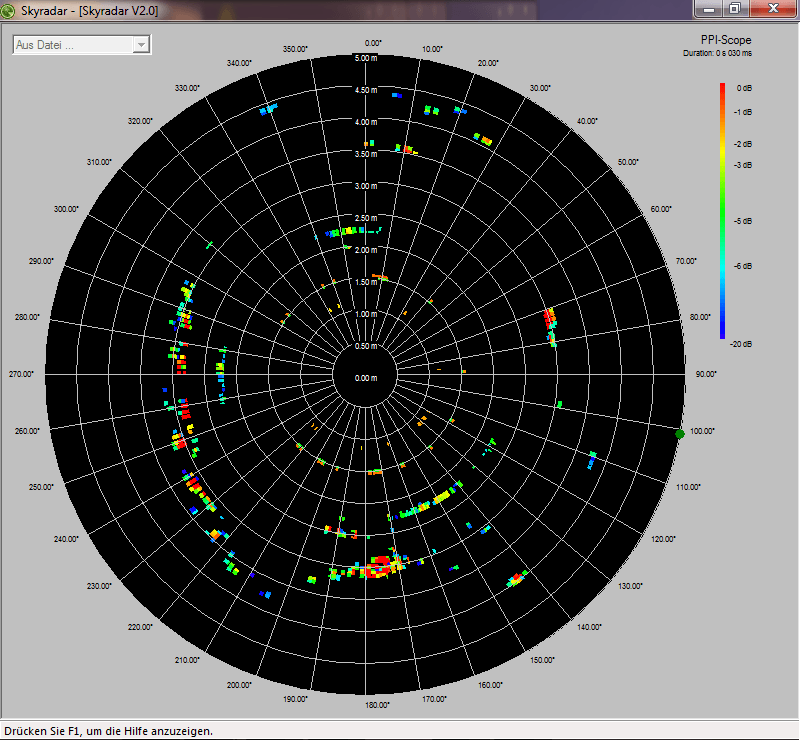Didactical Noiseradar “Skyradar Pro”
Description of the radar set, tactical-technical characteristics

Figure 1: Didactical Noiseradar, a sophisticated radar for training purposes, shown with a moving target.

Figure 1: Didactical Noiseradar, a sophisticated radar for training purposes, shown with a moving target.

| Specifications | |
|---|---|
| frequency: | 20 GHz … 28 GHz ( K-Band) |
| average power: | 3.2 mW |
| instrumented range: | 9,5 m |
| range resolution: | 7 … 30 cm |
| accuracy: | 3,5 cm |
| beamwidth: | 1° |
| MTBCF: | |
| MTTR: | |
Didactical Noiseradar “Skyradar Pro”
The Didactical Noiseradar based on proven modules for didactic radars in K-Band. It operates as a pulsed noise radar having an operating center frequency of 24 GHz and a bandwidth of 8 GHz. The transmission power is only 5 dBm and thus this radar is used exempt from authorization in most countries as UWB-Radar. This generous permission freedom relies basically in the fact that there are no measuring instruments which can register the radiation of a small group of a few pulses per second, each having a length in the lower picosecond range.
Structure

Figure 2: PPI scope of the Noiseradar, the geometry of the conference room is clearly visible on the display.

Figure 2: PPI scope of the Noiseradar, the geometry of the conference room is clearly visible on the display.
The Didactical Noiseradar offers several radar workstations. One of them is provided with special privileges (for example, the antenna control). This one workstation can be used by instructors for demonstration purposes. Its screen can be reproduced with a projector and is therefore visible to all course participants. Additional workstations are provided for the course participants. They may freely modify “their” channel of the radar receiver individually or in pairs on a separate workstation. The row-data from the Didactical Noiseradar is broadcasted to the students workstations using wireless LAN.
Specifications
The radar operates within the room for training course up to a distance of 9 m and with a range resolution of a few centimeters. This resolution is also dependent on the screen resolution. The maximum range of 9m at a bandwidth of 8 GHz is limited by the number of Range Cells that are given here constructively with 256. This is predetermined by the FPGA used. In practice, a range resolution of about 7 cm is achieved, which is sufficient for use in a classroom. This is due to the fact that the most reflective objects occupy several range cells due to their geometrical dimension. By reducing the bandwidth greater range can be achieved, although with a simultaneous degradation the resolution capability. The maximum range is also dependent on the maximum possible power transmitted. This power is fixed by the chip used.
Antenna
The antenna is a single curved parabolic antenna. It focuses the beam of the horn feed only in azimuth. However, the antenna reflector must be handled very carefully. An acceptable deformation is within the range of λ /₆₄, at a wavelength of 12 mm corresponding to a permissible error of about 0.2 mm. In the center of the parabolic antenna (place with the maximum power density), the surface is fixed by the two crossmembers in such a way that no deformation is possible.
The directivity of the parabolic reflector focuses the beam to a width of about one degree. Within a classroom, the radar can thus display on it's screen the walls, windows and furniture, as well as the present persons. Even lying around tools can be reliably detected by the radar. This indication of one degree, however, be interpreted with caution. At ideally parallel alignment of all parts of reflected power by the parabolic reflector the focused beam cannot be substantially narrower than the reflector itself. In the short-range within a lecture room this has the result that the beam formed by the antenna has got a width of about 70 cm (just as the width of this reflector).
Operating Modes
At the Didactical Noiseradar, however, the distance between the reflector and the transceiver may continuously be changed. Thus, the energy parts may not necessarily be ideal reflected parallel to each other. It can be a slightly greater distance to be set between the transceiver and the reflector so that the source of the radiation is outside of the antennas focus. Now the parabolic reflector focuses all energy parts of the beam at a point in, for example, 5 m distance. Near this point it can be achieved a much better angular resolution.
The movement of the antenna can be set both as a surveillance radar with 360 ° search mode, as well as a swivel type operation in a freely selectable sector(like a tracking radar). The software allows a representation of the radar information on an A-scope, PPI-scope and a B-scope. The B-scope may be modified both to as true B-scope with an angular scale, and otherwise with a time scale on the x-axis. (A time-based representation is often used in a Ground Penetrating Radar.) Different filters can be switched on which optimize the appearance of the display units. A free choice of STC function and a wide control range for thresholds as a noise barrier and as a limitation allows the trainees to set an optimal signal to noise ratio on it's individual display. They can therefore improve the probability of detection and observe the impact of the filters and threshold values.
The final assembling and distribution is now done by Köster Systemtechnik. There exist a version called Skyradar PRO using a software based on HTML and Javascript.